
Gavialidae is a family of large semiaquatic crocodilians with elongated, narrow snouts. Gavialidae consists of only two extant (living) members from Asia, the gharial and the false gharial, although many extinct members are known from a broader range, including the recently extinct Hanyusuchus. Gavialids are generally regarded as lacking the jaw strength to capture the large mammalian prey favoured by crocodiles and alligators of similar size so their thin snout is best used to catch fish, however the false gharial has been found to have a generalist diet with mature adults preying upon larger vertebrates.
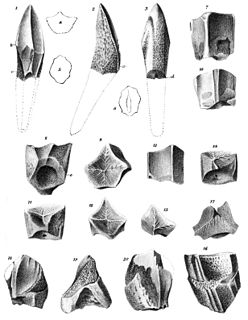
Trachodon is a dubious genus of hadrosaurid dinosaur based on teeth from the Campanian-age Upper Cretaceous Judith River Formation of Montana, U.S. It is a historically important genus with a convoluted taxonomy that has been all but abandoned by modern dinosaur paleontologists.
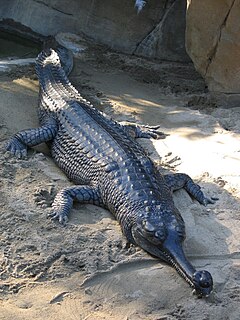
Gavialis is a genus of crocodylians that includes the living gharial Gavialis gangeticus and one known extinct species, Gavialis bengawanicus.G. gangeticus comes from the Indian Subcontinent, while G. bengawanicus is known from Java. Gavialis likely first appeared in the Indian Subcontinent in the Pliocene and dispersed into the Malay Archipelago through a path called the Siva–Malayan route in the Quaternary. Remains attributed to Gavialis have also been found on Sulawesi and Woodlark Island east of the Wallace Line, suggesting a prehistoric lineage of Gavialis was able to traverse marine environments and reach places possibly as far as western Oceania.
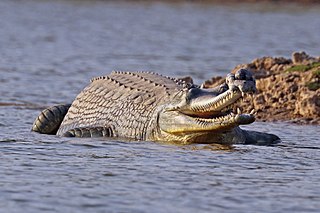
The gharial, also known as gavial or fish-eating crocodile, is a crocodilian in the family Gavialidae and among the longest of all living crocodilians. Mature females are 2.6–4.5 m long, and males 3–6 m. Adult males have a distinct boss at the end of the snout, which resembles an earthenware pot known as a ghara, hence the name "gharial". The gharial is well adapted to catching fish because of its long, thin snout and 110 sharp, interlocking teeth.

Lambeosaurus is a genus of hadrosaurid dinosaur that lived about 75 million years ago, in the Late Cretaceous period of North America. This bipedal/quadrupedal, herbivorous dinosaur is known for its distinctive hollow cranial crest, which in the best-known species resembled a hatchet. Several possible species have been named, from Canada, the United States, and Mexico, but only the two Canadian species are currently recognized as valid.
Claorhynchus is a dubious genus of cerapodan dinosaur with a confusing history behind it. It has been considered to be both a hadrosaurid and a ceratopsid, sometimes the same as Triceratops, with two different assignments as to discovery formation and location, and what bones make up its type remains.
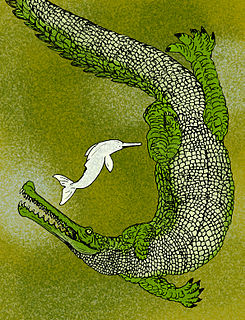
Rhamphosuchus is an extinct genus of gavialid crocodylians. It lived during the Miocene and its fossils have been found in two regions; the Siwalik Hills of Pakistan and India as well as the Sindh region of Pakistan. Its type species is Rhamphosuchus crassidens, which is only known from incomplete sets of fossils, mostly teeth and skulls. Four species traditionally placed in the genus Gavialis may be included as well.
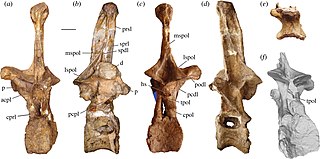
Amphicoelias is a genus of herbivorous sauropod dinosaur that lived approximately 150 million years ago during the Tithonian of what is now Colorado, United States. A herbivore, Amphicoelias was moderately sized at about 25 m (82 ft) long–roughly the same length as Diplodocus, to which it was related. Its hindlimbs were very long and thin, and its forelimbs were proportionally longer than in relatives.
Brachyuranochampsa is an extinct genus of crocodilian.
Eogavialis is an extinct genus of eusuchian crocodylomorph, usually regarded as a gavialoid crocodylian. It superficially resembles Tomistoma schlegelii, the extant false gharial, and consequently material from the genus was originally referred to Tomistoma. Indeed, it was not until 1982 that the name Eogavialis was constructed after it was realised that the specimens were from a more basal form.
Eothoracosaurus is an extinct genus of eusuchian crocodylomorphs which existed during the Late Cretaceous period. Thoracosaurs in general were traditionally thought to be related to the modern false gharial, largely because the nasal bones contact the premaxillae, but phylogenetic work starting in the 1990s instead supported affinities within gavialoid exclusive of such forms. Even more recent phylogenetic studies suggest that thoracosaurs might instead be non-crocodilian eusuchian.
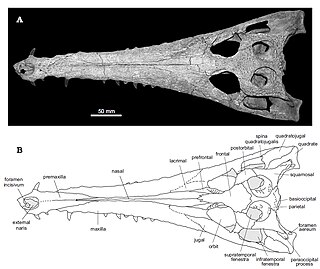
Eosuchus is an extinct genus of eusuchian crocodylomorph, traditionally regarded as a gavialoid crocodilian. It might have been among the most basal of all gavialoids, lying crownward of all other known members of the superfamily, including earlier putative members such as Thoracosaurus and Eothoracosaurus. Fossils have been found from France as well as eastern North America in Maryland, Virginia, and New Jersey. The strata from which specimens have been found date back to the late Paleocene and early Eocene epochs.

Gryposuchus is an extinct genus of gavialid crocodilian. Fossils have been found from Argentina, Colombia, Venezuela, Brazil and the Peruvian Amazon. The genus existed during the Miocene epoch. One recently described species, G. croizati, grew to an estimated length of 10 metres (33 ft). Gryposuchus is the type genus of the subfamily Gryposuchinae, although a 2018 study indicates that Gryposuchinae and Gryposuchus might be paraphyletic and rather an evolutionary grade towards the gharial.
Ikanogavialis is an extinct genus of gavialid crocodilian. Fossils have been found in the Urumaco Formation in Urumaco, Venezuela and the Solimões Formation of Brazil. The strata from which remains are found are late Miocene in age, rather than Pliocene as was once thought. A possible member of this genus survived into the Late Holocene on Muyua or Woodlark Island in Papua New Guinea.
Indraloris is a fossil primate from the Miocene of India and Pakistan in the family Sivaladapidae. Two species are now recognized: I. himalayensis from Haritalyangar, India and I. kamlialensis from the Pothohar Plateau, Pakistan. Other material from the Potwar Plateau may represent an additional, unnamed species. Body mass estimates range from about 2 kg (4.4 lb) for the smaller I. kamlialensis to over 4 kg (8.8 lb) for the larger I. himalayensis.

Gavialis browni is an extinct species of the crocodylian genus Gavialis and a close relative of the living gharial Gavialis gangeticus.

Pachyrhynchus is a genus of weevils in the family Curculionidae. Most species are found on Southeast Asian islands.

Astorgosuchus is an extinct genus of crocodilian, closely related to true crocodiles, that lived in Pakistan during the late Oligocene period. It contains a single species, A. bugtiensis, which was originally named as a species of Crocodylus in 1908 and was moved to its own genus in 2019.
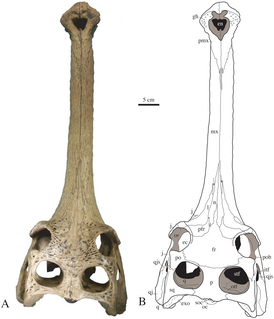
Gavialis bengawanicus is an extinct species of crocodilian that is related to the modern Indian gharial. Fossils have been found in Thailand and Indonesia. The type locality is at Trinil.
Gavialimimus is an extinct genus of plioplatecarpine mosasaur from the Maastrichtian of Morocco. The holotype MHNM.KHG.1231, an articulated skull and associated fragmentary postcrania, was found in the Ouled Abdoun Basin.















